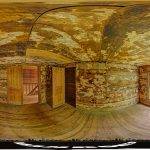Appuldurcombe House
Appuldurcombe House, a notable historical landmark on the Isle of Wight, presents a rich tapestry of English history, architecture, and personal drama. In this comprehensive exploration, we delve into the origins, evolution, and current state of this once-grand estate, uncovering the stories that have shaped its centuries-old legacy.
Image by: Daniel Pieternella
About the Appuldurcombe House
Origins and Evolution
Early Beginnings
- 1100 AD: Appuldurcombe’s story begins as a priory, evolving through several incarnations, including a convent and an Elizabethan home of the Leigh family.
Construction of the Current House
- 1702: The current Appuldurcombe House was initiated by Sir Robert Worsley, 4th Baronet. He envisioned replacing the existing Tudor mansion, which he dismantled completely.
- Architect: The house was designed by John James, a notable architect of the era.
- Sir Robert Worsley’s Demise: Sir Robert never saw the house completed, passing away in 1747.
Expansion and Notoriety
- 1770s Extensions: Great-nephew Sir Richard Worsley, 7th Baronet, significantly expanded the house. This era marked a high point in the mansion’s history, featuring a grand art collection and significant social events.
- Capability Brown’s Influence: The famed landscape designer was commissioned in 1779, contributing to the estate’s stunning grounds.
Architectural Significance
English Baroque Masterpiece
- Design: Appuldurcombe is an outstanding example of early 18th-century English Baroque architecture. Despite its current ruined state, it retains significant architectural elements and grandeur.
- Structure Details: The house features a square center with four oblong angle pavilions. Large Corinthian pilasters and a balustrade dominate the east-facing garden side, while the west-facing entrance was remodeled in the 1770s by Wyatt.
Personal Drama and Decline
Richard Worsley’s Troubled Life
- Marital Scandal: Sir Richard’s marriage to Seymour Fleming was marked by controversy, including a sensational court case and Seymour’s eventual life as a professional mistress.
- Financial Woes: Sir Richard left the estate heavily indebted, leading to a change in ownership to his niece, who married Charles Anderson-Pelham, the first Earl of Yarborough.
Changes in Ownership
- 1855: The estate was sold, undergoing various uses, including a hotel and a school.
- Early 20th Century: The house hosted Benedictine monks from 1901 to 1907.
World War Impact and Abandonment
- Military Use: The house was used for military purposes during both World Wars.
- 1943 Bombing: A Luftwaffe mine caused significant damage, leading to the collapse of part of the roof. This damage marked the beginning of the house’s decline into ruin.
Current Status and Preservation
- A Haunting Shell: Today, Appuldurcombe House is largely a shell, with some restoration efforts, such as the re-roofing and glazing of its front section. It’s known for its ghost stories and supernatural sightings.
- Public Access and Restoration: Managed by English Heritage, the house is open to the public, showcasing its nine-century history. Restoration efforts have included the marble floor in the entrance hall and the façade.
Conclusion
Appuldurcombe House stands as a testament to the ebb and flow of history, encapsulating moments of architectural brilliance, personal drama, and eventual decline. Its journey from a monastic cell to a Baroque masterpiece, and finally to a haunting ruin, offers a unique glimpse into England’s layered past.
If you liked this blog post, you might like the following, the Micanopy Restaurant in Central Florida, the Packard Automotive Plant in Michigan, or the Fort Tourgis in Guernsey.

A 360-degree panoramic image captured at the Appuldurcombe House in Wroxall, United Kingdom. Image by: Daniel Pieternella
Do you have 360-degree panoramic images captured in an abandoned location? Send your images to Abandonedin360@gmail.com. If you choose to go out and do some urban exploring in your town, here are some safety tips before you head out on your Urbex adventure.
Unlock the secrets of exploration by diving into precise GPS data available exclusively for an array of hidden gems and hundreds of other captivating sites, all within our members’ section. By investing in a Gold Membership, you’re not just gaining access; you’re securing a key to a vast, global archive of abandoned, untouched, and mysterious locations waiting to be discovered. Embark on your adventure with confidence, knowing every corner of the world can be within your reach. Don’t just observe—explore, discover, and claim the extraordinary journey that lies ahead with our treasure trove of world secrets. Subscribe now and transform the way you see the world! If you want to start shooting 360-degree panoramic images, you might want to look onto one-click 360-degree action cameras.
Click on a state below and explore the top abandoned places for urban exploring in that state.





